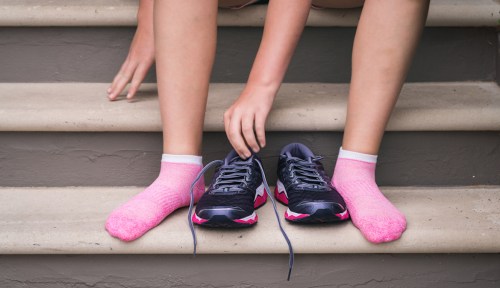Yes, Your Feet Can Change Over Time—Here’s How To Tell if You Need a New Shoe Size
Your feet can change in size over the course of your life. Here's how to know if your shoes don't fit and what causes these changes.

There’s nothing worse than a pair of aching feet. As you slump onto your couch and set your feet up for relief, you might even wonder why your feet seem to hurt even more than usual. News flash: It could simply be that your shoes don’t fit. (At least, not anymore.) We know what you’re thinking, but I’ve been this size forever. The thing is it’s entirely possible for your shoe size to change as you age or go through physical or hormonal changes (hi, pregnancy.)
Experts in This Article
This can come as a surprise when you’re wearing your trusted tennis shoes or beat-up Blundstones that have molded to your feet from constant wear. Podiatrist William Spielfogel, DPM, from the Good Feet Store, breaks down the signs that your shoes aren’t fitting quite right and what might be behind the change in size.
The most noticeable signs that your shoes don’t fit
“Painful issues such as blisters, ingrown nails, and painful bunions may be aggravated by ill-fitting shoes,” says Dr. Spielfogel. A too-tight shoe can also exacerbate other foot issues, like corns, hammertoes, and crossover toes, according to the American Academy of Orthopaedic Surgeons.
This doesn’t necessarily mean your shoes are causing these problems—but they still shouldn’t be rubbing your skin raw or causing constant pain. If your discomfort lasts for weeks, you’re probably past the “breaking in shoes” period, and it may be time to admit that your shoes actually don’t fit.
4 reasons your shoe size might change
If you’ve come to the conclusion that yes, your shoe size has changed, the next logical question is, what the heck happened? The truth is your shoe size can change for a number of reasons throughout your life. Here are the most common ones:
Getting older
“Your shoe size may change as you get older, not so much in length but in width,” says Dr. Spielfogel. Why? “Because the ligaments and tendons in the foot may weaken as you age, causing your foot to widen and your arch to flatten,” he says. That’s why it’s important to get a proper fitting every so often and make sure your shoes have enough support.
Weight changes
“Some causes of shoe size change could be weight gain which puts more pressure on your feet,” says Dr. Spielfogel. That extra pressure may cause your feet to widen or lengthen slightly. This isn’t inherently negative, though, and weight changes are simply part of life.
Pregnancy
“The hormonal changes experienced during pregnancy which leads to an overall loosening of the ligaments, can affect your shoe size as well,” says Dr. Spielfogel. This can come as a surprise to postpartum people looking to return to their old shoes only to find that they don’t fit the way they used to— even spurring brand-new blisters to pop up.
Manufacturing differences
One other way that your shoe size may seem to vary is that there is no standard sizing across types of shoes and brands. Therefore, being sized appropriately is important, and trying on shoes before purchase is crucial to a good fit, says Dr. Spielfogel. This is especially true when you switch between international shoe brands. For instance, some U.K. brands use half sizes to indicate increased width, not length, which is different from U.S. brands. Reading the fine print on your shoe brands’ site or talking to a sales associate can be helpful when getting a new pair of shoes. You can also ask for a fitting at many shoe stores.
It can be really hard to admit that your favorite pair of shoes are just… not compatible with your feet. But, bloody blisters are just not worth the fashion statement. (Just ask your toes!) If you’re frustrated about the additional cost of finding a better size, know that buying your shoes from certain brands or department stores (like Nordstrom) may offer return policies that allow you to size up at no extra charge.
Sign Up for Our Daily Newsletter
Get all the latest in wellness, trends, food, fitness, beauty, and more delivered right to your inbox.
Got it, you've been added to our email list.










